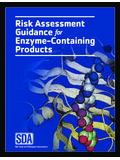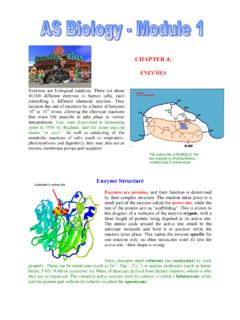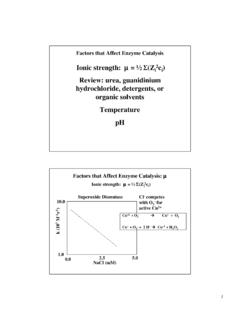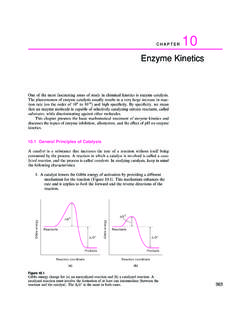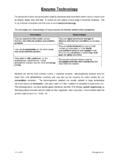Transcription of The Moderately Efficient Enzyme: Evolutionary and ...
1 Published:April 20, 2011r2011 American Chemical |Biochemistry2011, 50, 4402 4410 CURRENT Moderately Efficient Enzyme: Evolutionary and PhysicochemicalTrends Shaping Enzyme ParametersArren Bar-Even, Elad Noor, Yonatan Savir, Wolfram Liebermeister, Dan Davidi, Dan S. Tawfik, andRon Milo*, Department of Plant Sciences, Department of Physics of Complex Systems, and Department of Biological Chemistry, The WeizmannInstitute of Science, Rehovot 76100, IsraelbSSupporting InformationNatural selection shapes the regulation of metabolic enzymesenforcing precise spatial and temporal control. It also plays acentral role in the evolution of enzymatic kinetic parameters,including the turnover number (kcat) and the apparent bindingconstants of substrates (KM), as both these parameters, togetherwith enzyme concentrations, affect metabolism and growth literature usually highlights kinetically supreme enzymessuch as triosephosphate isomerase, commonly termed a perfectenzyme.
2 1,2 What, however, are the kinetic parameters of the average enzyme ? Are most enzymes similarly perfect , and ifnot, why? Here we describe a global view of enzyme parameterswith the aim of highlighting the forces that shape the catalyticefficiency of large body of literature discusses the complex interplayamong the various parameters of enzymatic catalysis,3 9yet theselective pressures that shaped these parameters remain largelyunclear. While traditionallykcat/KMwas thought to be anoptimized quantity,4,8 10other alternatives were ,11,12 For example,KMvalues may have evolved to match physiologicalsubstrate concentrations,13while a substrate-saturated enzyme isexpected to maximizekcatand to be insensitive ,14 There are also several known physicochemical constraintsthat set boundaries to kinetic ,16 For example,theoretical limitations suggest thatkcatis unlikely to be higherthan 106 107s ,17 Furthermore, the apparent second-orderrate for a diffusion-limited enzyme-catalyzed reaction with asingle low-molecular mass substrate (kcat/KM) cannot exceed 108 109s 1M ,19 The activation energy of the reaction,as reflected in the uncatalyzed rate, also comprises a barrier.
3 Theenzymatic acceleration of an extremely slow reaction, even bymany orders of magnitude, may still result in a relatively slowcatalyzed overall thermodynamics of a reaction addsfurther limits. The Haldane relationship20states a dependencybetween thekcat/KMof the forward (F) and backward (B)reactions, such thatKeq=(kcat/KM)F/(kcat/KM)B, whereKeqisthe reaction s equilibrium constant. Therefore, even whenkcat/KMin the favorable direction is diffusion-limited,kcat/KMfor theunfavorable direction would be far lower than this there are no obvious limitations onKM, previousstudies have demonstrated that physicochemical propertiesof ligands and substrates correlate with their binding affinities(KS) toward receptors and example is theoctanol water partition coefficient (LogP), the ratio of concen-trations of a compound partitioning between a hydrophobicReceived:February 14, 2011 Revised:April 11, 2011 ABSTRACT:The kinetic parameters of enzymes are key to understanding the rateand specificity of most biological processes.
4 Although specific trends are frequentlystudied for individual enzymes , global trends are rarely addressed. We performed ananalysis ofkcatandKMvalues of several thousand enzymes collected from theliterature. We found that the average enzyme exhibits akcatof 10 s 1and akcat/KMof 105s 1M 1, much below the diffusion limit and the characteristic textbookportrayal of kinetically superior enzymes . Why do most enzymes exhibit moderatecatalytic efficiencies? Maximal rates may not evolve in cases where weaker selectionpressures are expected. Wefind, for example, that enzymes operating in secondarymetabolism are, on average, 30-fold slower than those of central metabolism. Wealsofind indications that the physicochemical properties of substrates affect thekinetic parameters. Specifically, low molecular mass and hydrophobicity appear tolimitKMoptimization. In accordance, substitution with phosphate, CoA, or otherlarge modifiers considerably lowers theKMvalues of enzymes utilizing the substituted substrates.
5 It therefore appears that bothevolutionary selection pressures and physicochemical constraints shape the kinetic parameters of enzymes . It also seems likely thatthe catalytic efficiency of some enzymes toward their natural substrates could be increased in many cases by natural or |Biochemistry2011, 50,4402 4410 BiochemistryCURRENT TOPIC phase and a water phase. This indicator of hydrophobicity wasfound to correlate with the binding energy of certain substratestoward their 24In addition, previous studies found acorrelation between the molecular mass of ligands and theirreceptor binding ,26 However, while binding of ligandsto receptors is a relatively simple process, theKMis a macroscopicvalue affected by microscopic rates that relate to substratebinding but also to enzymatic the physicochemical considerations, it was also sug-gested that the evolution of enzyme efficiency is dependent onthe enzyme s function within the organism and specific cases were found to support this suggestion( , ref 27).
6 On the other hand, it appears that for manyenzymes, significant reductions in rate have no effect, and onlyrelatively large reductions in catalytic efficiency hamper organis-malfitness (ref 28 and references cited therein). Thus, although itis presumed that both Evolutionary selection pressures andphysicochemical constrains affect enzymes , the effects of thesetwo factors on enzyme kinetic parameters are currently we present a global analysis of the kinetic parameters ofenzymes. We aim to highlight global factors shaping kineticparameters of enzymes rather than to discuss specific casestudies. To allow such a global analysis, we have mined theBrenda29and KEGG30databases. The Brenda database containsthe kinetic parameters for thousands of enzymes and substratescollected from the literature. Using the KEGG database, wedistinguished the parameters for the natural substrates of theseenzymes from those of non-native, promiscuous substrates(Supporting Information).
7 In this way, we could separatelyanalyze the kinetic parameters for the natural substrates, avoidingbiases from other parameters. Such a distinction has notbeen made in previously published distributions of ,31 The KEGG database has also allowed us toassign a metabolic pathway for each reaction. Ourfinal data setcontained 5000 unique reactions, utilizing 2500 uniqueenzymes and 1500 unique substrates (Table 1 and Figure S1of the Supporting Information). The entire data set of the kineticparameters is given in the Supporting expected, such a data set of published kinetic parametershas considerable variability and noise as shown in Table S1 anddiscussed in detail in the Supporting Information. This can beattributed to varying measurement conditions, such as pH, tem-perature, ionic strength, and the concentrations of metals andcofactors, as well as differences in experimental methodologies,and inconsistencies between the values in the original papers andthe values entered in the Brenda database (Supporting In-formation).
8 Further, most parameters in the literature are mea-sured in vitro, which can be considerably different from thosemeasured in ,33 These differences can be as great as 3 ordersof will be worthwhile to revisit our results as morein vivo data become available. However, it is unlikely that suchdifferences will account for the systematic trends we observe. Inaddition, temperature significantly affects the kinetic parameters;34on average,kcatdoubles from 25 to 37 C (Figure S2 of theSupporting Information). However, we tested such effects andfound that none of the trends described below results from asystematic bias in assay temperatures (or pH values).Overall, the noisy nature of the data collected from theliterature limits the resolution of any global analysis and thuslimits the study to prominent differences consistently observed inlarge samples. Moreover, certain subgroups of enzymes mightdisplay specific behavior not evident in other groups, therebymasking global trends.
9 Nevertheless, as discussed below, a globalanalysis does uncover several general trends that underlie kineticparameters. THE AVERAGE ENZYME IS FAR FROM KINETICPERFECTIONThe median turnover number for the entire data set ofenzymes and natural substrates is 10 s 1(Figure 1A), wheremostkcatvalues ( 60%) are in the range of 1 100 s 1. Theserates are orders of magnitude slower than the textbook examplesof fast enzymes [ , carbonic anhydrase (Figure 1A)], let alonecompared to the theoretical limit of 106 107s ,17 Themediankcat/KMis 105M 1s 1(Figure 1B), where mostkcat/KMvalues ( 60%) lie in the range of 103 106M 1s 1,orders of magnitude below the diffusion limit. Although poolingall enzymes to one distribution is conceptually problematic, thisprovides a unique perspective for a comparison of enzymes . Forexample, Rubisco, the central carbonfixation enzyme, is usuallyconsidered to be a slow and inefficient ,Figure 1 suggests that it actually possesses rather average considering the maximalkcat/KMof each enzyme, themediankcat/KMis only 5-fold higher ( 5 105M 1s 1),suggesting that constraints imposed by the Haldane relationship,and the multisubstrate reactions of enzymes , only partiallyexplain why many enzymes operate far from the theoreticalkinetic note that previous studies have shown that not alldiffusion-controlled reactions operate atkcat/KMvalues of108 109M 1s 1.
10 The kinetic parameters for some enzymescould be limited by the rate of substrate enzyme encounter, assuggested by the viscosity dependence ofkcat/KM, although theydisplaykcat/KMvalues in the range of 106M 1s 40In suchcases, the lowkcat/KMvalues may reflect the recruitment of a rareenzyme conformation that mediates catalytically ,40 The medianKMis 100 M (Figure 1C), where 60% of allKMvalues are in the range of 10 1000 M. The distribution ofKMvalues implies an empirical constraint for theKMof metabolicTable 1. Data Extracted for Our Analysisafilterno. ofKMvaluesno. ofkcatvaluesKMandkcatBrenda, all data9251636021 Brenda, removing mutants7659125157 Brenda, acting on KEGG natural substrates 311626530unique reactions(enzyme substrate pairs)51941942 1882unique enzymes25881176 1128unique substrates1612834804aEach of thefirst three rows corresponds to the kinetic parametersdownloaded from the Brenda website andfiltered as described in theSupporting Information.
